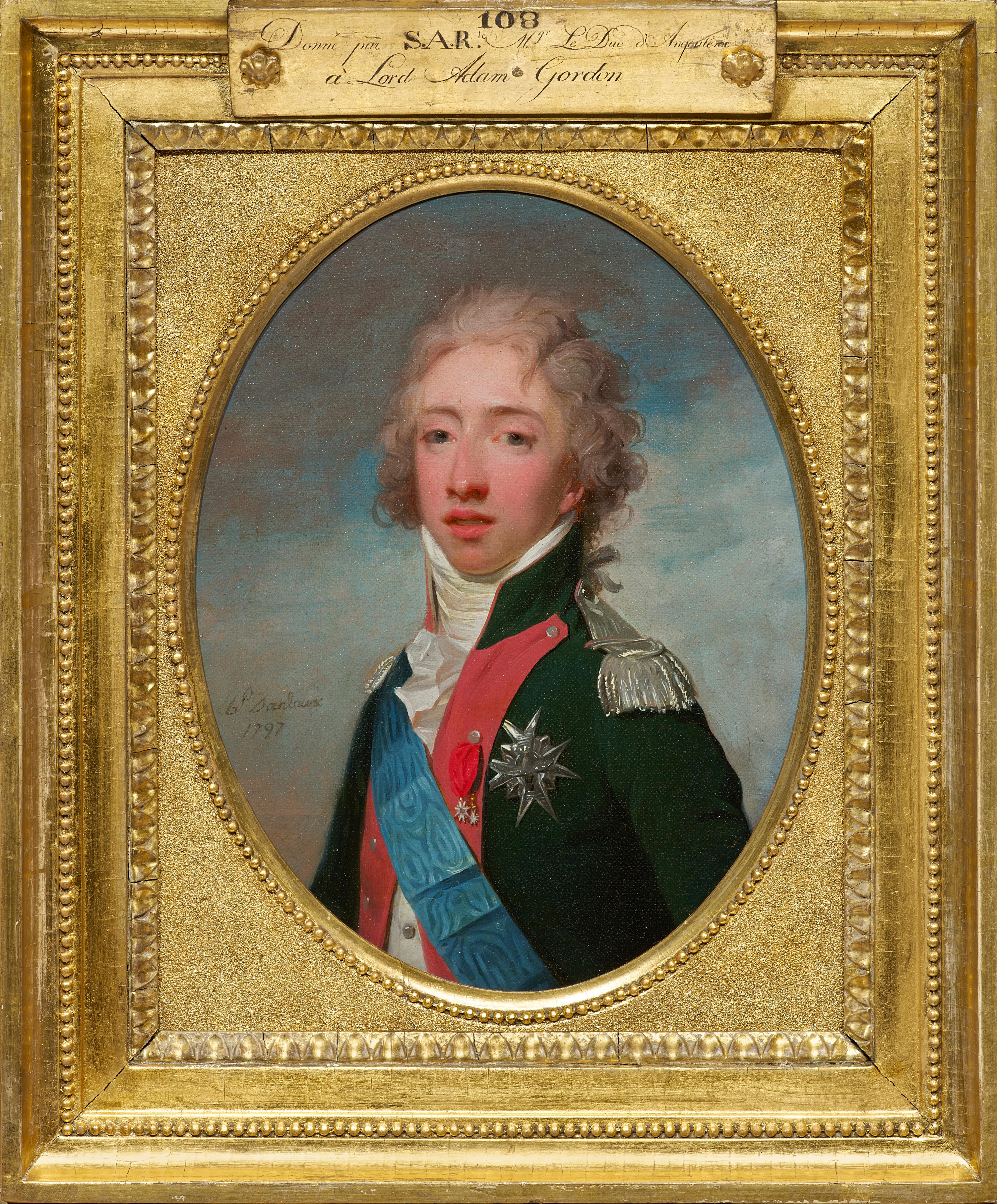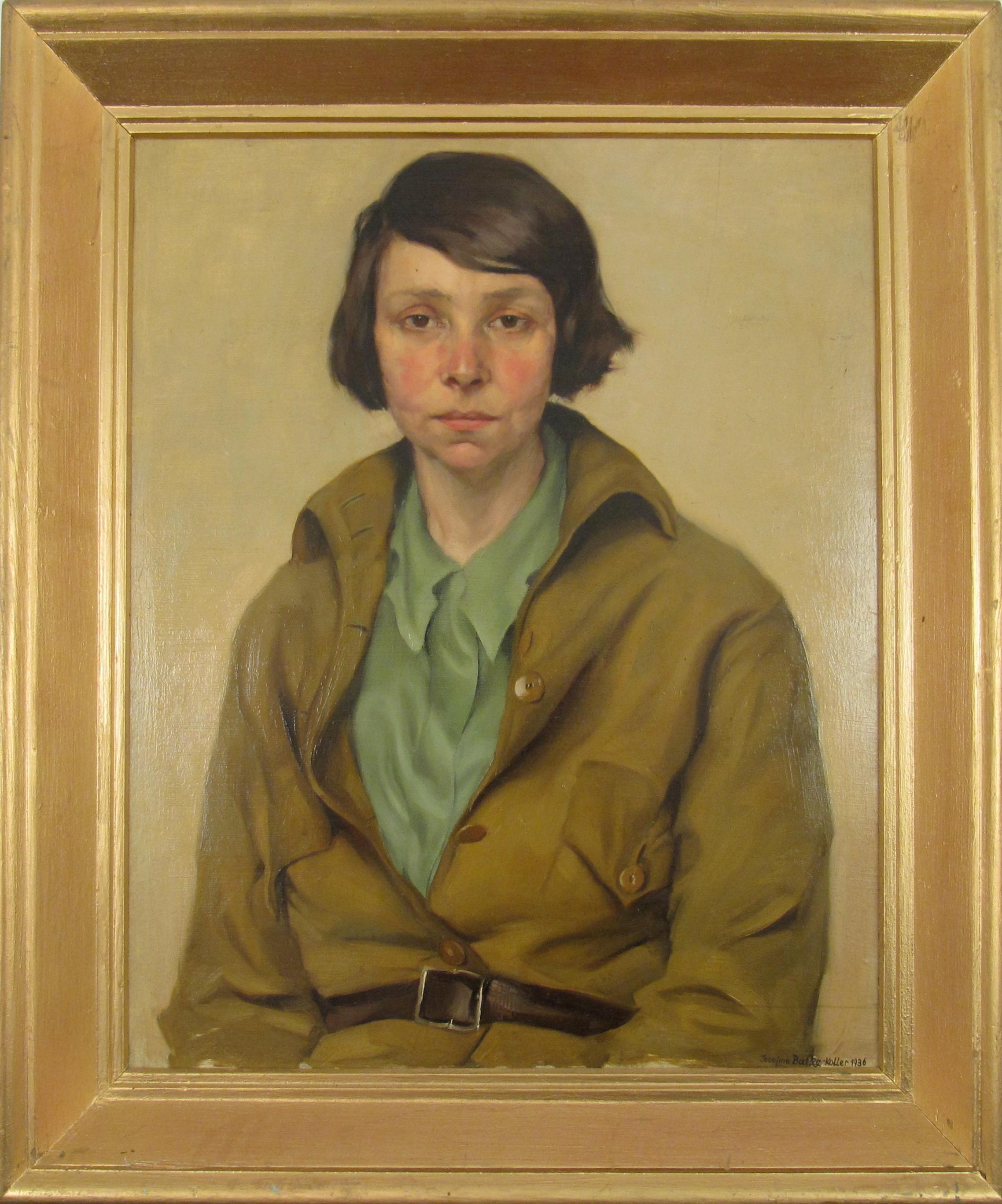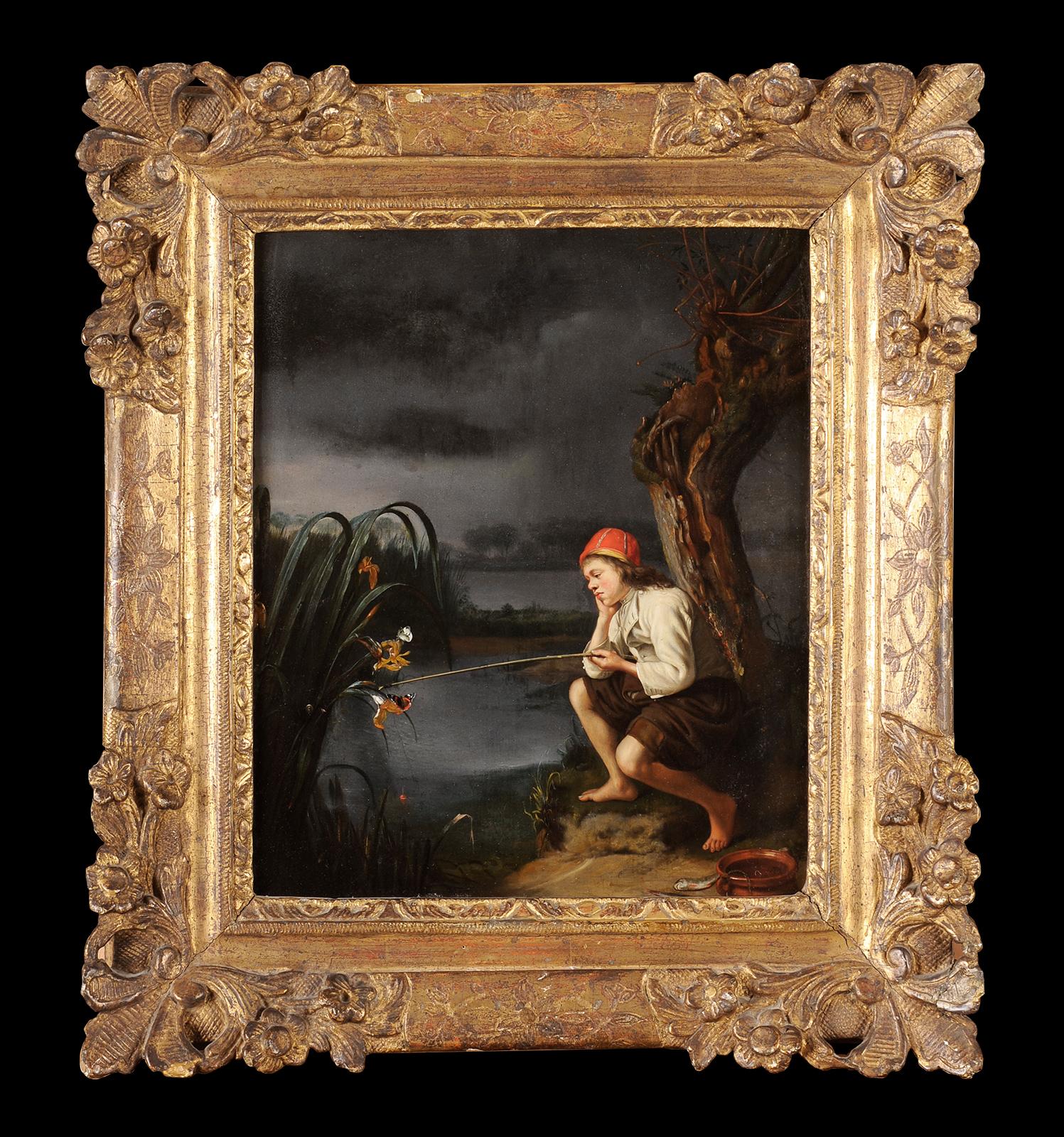Items Similar to Portrait Of King Edward VI (1537-1553) as Prince Of Wales, 16th Century
Want more images or videos?
Request additional images or videos from the seller
1 of 11
UnknownPortrait Of King Edward VI (1537-1553) as Prince Of Wales, 16th Century
About the Item
Portrait Of King Edward VI (1537-1553) as Prince Of Wales, 16th Century
English School - Oil on panel - circa 1547
Large 16th Century portrait of Edward VI as Prince Of Wales, oil on panel. Early and important portrait of the young monarch, son of Henry VIII and Jane Seymour, in anticipation of the crown holding a flower. One of a pair, the other depicting him as King of England & Ireland. Framed. Some losses and panel bowing. We can quote for full restoration.
Provenance: A private collection, UK
Measurements: 37" x 30" framed approx
- Dimensions:Height: 37 in (93.98 cm)Diameter: 30 in (76.2 cm)
- Medium:
- Period:
- Condition:
- Gallery Location:Blackwater, GB
- Reference Number:
About the Seller
4.8
Platinum Seller
These expertly vetted sellers are 1stDibs' most experienced sellers and are rated highest by our customers.
Established in 2008
1stDibs seller since 2021
193 sales on 1stDibs
Typical response time: 1 hour
- ShippingRetrieving quote...Ships From: Blackwater, United Kingdom
- Return PolicyA return for this item may be initiated within 14 days of delivery.
More From This SellerView All
- The Hunting Party, Scottish Moors, 19th Century by ROBERT CLEMINSON (1844-1902Located in Blackwater, GBThe Hunting Party, Scottish Moors, 19th Century by ROBERT CLEMINSON (1844-1902) similar to $15,000 Large 19th century Scottish Moors Hunting Party, oil on canvas by Robert Clemins...Category
19th Century Portrait Paintings
MaterialsOil, Wood Panel
- Portrait Of King Henry VIII (1491-1547) Of England, 16th CenturyBy Hans HolbeinLocated in Blackwater, GBPortrait Of King Henry VIII (1491-1547) Of England, 16th Century circle of HANS HOLBEIN (1497-1543) 16th Century English court portrait of King Henry VIII as King of England, oil o...Category
16th Century Portrait Paintings
MaterialsOil, Wood Panel
- The Blood Of Christ, The Milk Of The Madonna, 16th CenturyLocated in Blackwater, GBThe Blood Of Christ, The Milk Of The Madonna, 16th Century circle of Adriaen Isenbrandt (1480-1551) Huge 16th Century Flemish old Master depiction of...Category
16th Century Portrait Paintings
MaterialsOil, Wood Panel
- Coronation Portrait Of King Edward VI (1537-1553) as King Of England & IrelandLocated in Blackwater, GBCoronation Portrait Of King Edward VI (1537-1553) as King Of England & Ireland, 16th Century English School - Oil on panel - circa 1547 Large 16th Century Coronation portrait of E...Category
16th Century Portrait Paintings
MaterialsWood Panel, Oil
- King Solomon Worshipping The Idols, 17th Century FRANS FRANCKEN II (1581-1642)By Frans Francken IILocated in Blackwater, GBKing Solomon Worshipping The Idols, 17th Century FRANS FRANCKEN II (1581-1642) - signed sales to $6,000,000 Large 17th Century biblical account of King Solomon worshipping the Idols, oil on panel Frans Francken. Excellent quality and condition Old Testament biblical scene on a cradled panel depicting the Idolatry of Solomon, son and successor of King David. Exceptional detail and would be enhanced with a light clean. Presented in an antique period frame. Signed. Measurements: 47" x 34" framed approx Artist Biography Frans Francken II or the Younger is the third in order of descent in the Francken family tree. Born in 1581, the son of Frans Francken I or the Elder, he was the brother of Thomas, born in 1574, of Hieronymous II, born in 1578 and died in 1623, and of Ambrosius II, the last in line, who died in 1632. Hieronymous II, who died at the age of 56, is only known for his painting Horatius Cocles at Sublicius Bridge. Frans the Younger was initially a pupil of his father, who was then at the height of his career. In his father's studio he imbibed all the teaching of the tradition of Frans Floris. He also spent long periods in Italy, where he familiarised himself in particular with the masters of the Venetian school. Such study in situ enabled him to break away from the well-worn methods of Flemish Italianism, as practised by his father and uncles. It is conceivable that the young artist met Rubens, who was in Italy at the time. In 1605, at the age of 24, on his return to Antwerp, Frans the Younger became a master in the Antwerp Guild of St Luke. In 1607 he married Elisabeth Placquet in Antwerp. Three sons and eight daughters resulted from this marriage. His children made up the fourth generation in the dynasty. Better known are Frans III (1607-1667) and Hieronymus, born in 1611. The latter had a son, Constantinus (1661-1717), who marks the end of the line. The family of Francken painters runs from 1520 to 1717. As one of the most active masters in Antwerp, Frans II was appointed dean of the guild in 1614. He was also a member of the Violette, a major literary association, for which he painted an award-winning symbolic coat of arms. He was intimate with the most celebrated artists, in particular van Dyck, who executed a very fine portrait of him, judging by the engraving by Willem Hondius and Pieter de Jode. It is also likely that he was on familiar terms with Rubens who was his near contemporary. He died in Antwerp on 6 May 1642 at the age of 61, outlived by both Rubens and van Dyck. The first securely dated work of Frans the Younger is Christ on the Cross from the gallery in Vienna, painted in 1606. Witches' Sabbath (Vienna) and The Works of Mercy (Antwerp) are dated 1607 and 1608 respectively. In these two latter works the painter proves himself adept at painting figures and allegorical scenes. The Works of Mercy represents various groups of figures, symbolising the different activities inspired by Christian charity. Paupers and beggars occupy the foreground, the ensemble being dominated by the figure of the glorious Christ. While Frans the Younger cannot be compared with the masters of this great first generation of Antwerp, which was illuminated and steered by the genius of Rubens, he does nevertheless merit attention. He succeeded in developing and bringing into fashion an anecdotal genre on a more modest scale, elements of which were to inform the last representatives of the Francken family for over a century. Frans the Younger was undoubtedly the most talented draughtsman in the family. While his art may be criticised for its lack of grandeur and solemnity, the execution shows great talent. His brush stroke was vigorous and his imagination, albeit restrained, was brilliant. His interest in tonal values was highlighted by his study and appreciation of his remarkable contemporaries. This enabled him to carry out landscapes and also fleshy figures, which made him altogether worthy of the brilliant period to which he belonged. While detail certainly preoccupied him, he treated it with intelligence and even esprit, as witnessed in The Parable of the Prodigal Son and A Prince's Visit to the Treasury of a Church(both in the Louvre). The scenes painted in grisaille, which surround the principal motif of the Prodigal Son, are characteristic of his style. He excelled in painting jewellery, ornaments, and textiles with shot silk effects. A large number of his figures inhabit the neutral backgrounds of the interiors of apartments and galleries. He carried out such work not only under his own auspices, but also for other artists, such as Peeter Neeffs, van Bassen, Josse de Momper...Category
17th Century Portrait Paintings
MaterialsWood Panel, Oil
- Portrait Of Elizabeth Percy, Countess of Northumberland (1646-1690) 17th CenturyBy Daniel MytensLocated in Blackwater, GBPortrait Of Elizabeth Percy, Countess of Northumberland (1646-1690), 17th Century Studio of Jan MYTENS (1640-1670) Large 17th portrait of Elizabeth Percy Countess of Northumberlan...Category
17th Century Portrait Paintings
MaterialsWood Panel, Oil
You May Also Like
- Two royal portraits (the Duc d'Angoulême and the Duc de Berry) by H.P. DanlouxLocated in PARIS, FRThese two royal portraits are a major historical testimony to the stay of the Comte d'Artois (the future Charles X) and his family in Edinburgh in 1796-1797. Given by the sitters to Lord Adam Gordon, the Governor of Edinburgh, and kept by family descent to this day, these two portraits provide us with a vivid and spontaneous image of the Duc d’Angoulême and his brother the Duc de Berry. Danloux, who had emigrated to London a few years before, demonstrate his full assimilation of the art of British portrait painters in the brilliant execution of these portraits. 1. Henri-Pierre Danloux, a portraitist in the revolutionary turmoil Born in Paris in 1753, Henri-Pierre Danloux was first a pupil of the painter Nicolas-Bernard Lépicié (1735 - 1784) and then, in 1773, of Joseph-Marie Vien (1716 - 1809), whom he followed to Rome when, at the end of 1775, Vien became Director of the Académie de France. In Rome he became friends with the painter Jacques-Louis David (1748 - 1825). Returning to France around 1782, he settled in Lyon for a few years before returning to Paris in 1785. One of his first portraits was commissioned by the Baroness d'Etigny, the widow of the former Intendant of the Provinces of Gascony, Bearn and Navarre Antoine Mégret d'Etigny (1719 – 1767). He then became close to his two sons, Mégret de Sérilly and Mégret d'Etigny, who in turn became his patrons. In 1787, this close relationship with the d'Etigny family was further strengthened by his marriage to Antoinette de Saint-Redan, a relative of Madame d'Etigny. After his marriage, he left for Rome and did not return to France until 1789. It was during the winter of 1790-1791 that he painted one of his masterpieces, the portrait of Baron de Besenval. Set in a twilight atmosphere, this portrait of an aristocrat who knows that his death is imminent symbolizes the disappearance of an erudite and refined society which would be swept away by the French Revolution. The Jacobin excesses led Danloux to emigrate to England in 1792; many members of his family-in-law who remained in France were guillotined on 10 May 1794. Danloux enjoyed great success as a portrait painter in England before returning to France in 1801. During his stay in England, Danloux was deeply under the influence of English portraitists: his colors became warmer (as shown by the portrait of the Duc d'Angoulême that we are presenting), and his execution broader. 2. Description of the two portraits and biographical details of the sitters The Duc d'Angoulême (1775-1844) was the eldest son of the Comte d'Artois, the younger brother of King Louis XVI (the future King Charles X), and his wife Marie-Thérèse of Savoie. He is shown here, in the freshness of his youth, wearing the uniform of colonel-general of the "Angoulême-Dragons" regiment. He is wearing the blue cordon of the Order of the Holy Spirit, which was awarded to him in 1787, and two decorations: the Cross of Saint-Louis and the Maltese Cross, as he was also Grand Prior of the Order of Malta. Born on 16 August 1775 in Versailles, Louis-Antoine d'Artois followed his parents into emigration on 16 July 1789. In 1792, he joined the émigrés’ army led by the Prince de Condé. After his stay in Edinburgh (which will be further discussed), he went to the court of the future King Louis XVIII, who was in exile at the time, and in 1799 married his first cousin Marie-Thérèse Charlotte of France, the daughter of Louis XVI and the sole survivor of the royal family. The couple had no descendants. He became Dauphin of France in 1824, upon the accession to the throne of his father but played only a minor political role, preferring his military position as Grand Admiral. Enlisted in Spain on the side of Ferdinand VII, he returned home crowned with glory after his victory at Trocadero in 1823. He reigned for a very short time at the abdication of Charles X in 1830, before relinquishing his rights in favor of his nephew Henri d'Artois, the Duc de Bordeaux. He then followed his father into exile and died on 3 June 1844 in Gorizia (now in Italy). His younger brother, the Duc de Berry, is shown in the uniform of the noble cavalry of the émigrés’ Army. He is wearing the blue cordon of the Order of the Holy Spirit, awarded to him in May 1789, and the Cross of Saint-Louis (partly hidden by his blue cordon). Born on 24 January 1778 in Versailles, Charles-Ferdinand d'Artois also followed his parents into emigration and joined the émigrés’ army in 1792. After his stay in Edinburgh, he remained in Great Britain, where he had an affair with Amy Brown...Category
1790s Old Masters Portrait Paintings
MaterialsCanvas, Oil, Wood Panel
- Robert von Steiger (1856-1941) Portrait Dutch Officer A. v. Steiger 1884 HollandLocated in Meinisberg, CHJohann Ludwig Robert von Steiger (Swiss, * 8th of January, 1856, Rio de Janeiro, Brazil; † 1st of June, 1941, Buenos Aires, Argentina) Portrait of Karl Alfred Arthur von Steiger Lie...Category
1880s Victorian Portrait Paintings
MaterialsWood Panel, Oil
- Josefine Batke - Koller (Austrian, 1897-1976) Jewish Brigadist Oil Painting 1936By Josefine Batke-KollerLocated in Meinisberg, CHJosefine Batke - Koller (Austrian, 1897-1976) Portrait of a Young, Jewish Communist Brigadist from the Spanish Civil War • Oil on panel ca. 60 x 49 cm • Frame ca. 75 x 62 cm • Sign...Category
1930s Naturalistic Portrait Paintings
MaterialsOil, Wood Panel
- Barend Graat (1628-1709) Diana the huntress and her dogsLocated in BELEYMAS, FRBarend GRAAT (Amsterdam 1628 – Amsterdam 1709) Diana the Huntress Oil on wood H. 33.5 cm; L. 44 cm Signed lower right on the stone A discreet painter with respect to history, Barend...Category
1650s Dutch School Figurative Paintings
MaterialsWood Panel, Oil
- Young fisher - Phlegmatism allegoryLocated in BELEYMAS, FRAttributed to Godfried SCHALKEN (Made 1643 – The Hague 1706) Young fischer Oil on panel in one board H. 32.5 cm; L. 25.5 cm Around 1670/75 Related works: - Autograph version with numerous variants, Berlin, Gemaldegalerie, Inv. N°837 - Copy or workshop version of our painting with slight variations but of inferior quality, Germany, sold at Berlinghof Auktionshaus in 2002 The object of this notice is not to produce a biography of Schalken, the reference work by Thierry Beherman published by Maeght in 1988. The goal here is to understand this version of a painting of formidable craftsmanship and to compare it to the work preserved in Berlin with its many variants in order to draw some hypotheses for conclusions Our young angler is a very interesting subject that can be found as early as the 16th century to invoke one of the four temperaments. Not melancholy as one might think at first glance, but phlegmatic character. The interpretation of astrological symbols closely linked peach and phlegm, laziness, slowness, often represented alongside the moon. Here the composition is very clear in this sense. The young man, chin resting on his arm, looks at his modest cane, the cork of which he soaks alongside snails and butterflies located in the Irises. All near a willow under a heavy sky, like a night sky. All the elements are there to give an explanation of the subject and not to leave the spectator in front of a simple genre scene. Let's go back to the willow, a tree that loses its fruits before they mature. It is often considered a symbol of lost youth, a reference to passivity or times of debauchery. Plato advised in his time to banish fishing from the education of children since it is an activity of expectation and not of exercise or reflection. Needless to explain the presence of small slow-moving animals with short lives or flowers… The image speaks for itself! Let's go back to the differences between the Berlin version and ours, of which it must be recognized that the quality is slightly lower and therefore can hardly be given with certainty to Schalken itself. This version has some additional elements compared to ours. In our version, the row of willows cut into trunks located to the left of the composition is replaced by a simple area of reeds that opens up to a luminous sky. The sky is also different by the clouds represented. A white butterfly flying in the middle of the Irises has been removed, as has a large leaf located on the back of the young fisherman at the foot of the willow. Only addition to our table in addition to the Berlin version: a second fish near the earthen pot...Category
1680s Flemish School Figurative Paintings
MaterialsWood Panel, Oil
- Emperor CaligulaLocated in Milano, MIUrbex is the English acronym for urban exploration and is an activity that consists of searching for and locating abandoned infrastructure with the goal of visiting, photographing an...Category
2010s Contemporary Portrait Paintings
MaterialsSandstone





